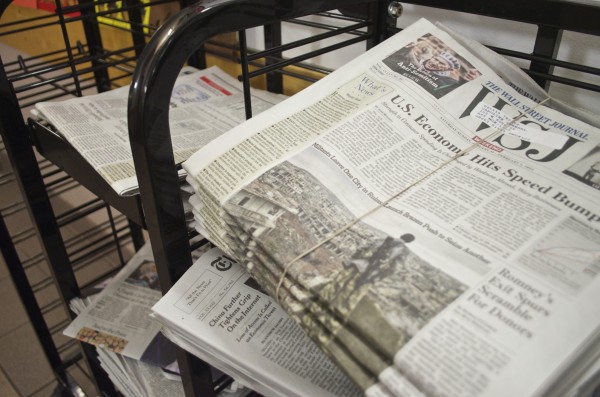NY Times Access Scales Back for Commuters
Residents have access to free digital and hard copy, while commuters only have access to digital. (Paula Madero/The Observer)
February 26, 2015
As commuter students have likely noticed, the Office of Student Leadership and Development (OSLCD) policy of providing hard copy newspapers outside of the office of student affairs room 408 has stopped, while McMahon residents continue to receive hard copies of The New York Times.
Additionally, Fordham College at Lincoln Center (FCLC) resident students have access to hard copies of The Wall Street Journal, which was offered via free subscription during the beginning of the year to students in the Gabelli School of Business at Lincoln Center (GSBLC) and continues to be mistakenly delivered McMahon Hall instead of McKeon Hall, where all resident business students at Lincoln Center reside.
Delivery and receival issues have troubled both of the hard copy newspapers, according to Keith Eldredge, dean of students at FCLC, leading to a push for digital subscriptions to both of the papers.
In past years, there have been many problems keeping The New York Times hard copies exclusive to undergraduates, according to Eldredge. “One of the things that we noticed that it was challenging to have the newspapers outside of 408 and keep them exclusive to commuting students … we would see employees, faculty and administrators picking up the newspapers,” he said.
As a result, the hard copies outside of 408 were removed in favor of an online subscription program, marketed specifically toward commuter students. “We tried to encourage this program for commuters at commuter orientation and in the newsletter … it’s not something we’d announce at resident floor meetings per se,” Eldridge continued. “Residents are welcome to use the online passes if they wish.”
As a result of this new program, hard copy subscription numbers have been cut in half. “We have around 80 [hard copy] newspapers delivered to McMahon … in previous years, it was around 160, 80 in McMahon and another 80 outside of 408,” Eldridge continued. “We purchased additional online subscriptions this year as well to compensate for the change.”
According to the New York Times website, “Colleges that purchase bulk newspaper copies for a New York Times daily readership program receive a number of NYTimes.com Academic Passes at no additional charge.”
“We were already receiving an equivalent number of digital subscriptions with the paper subscriptions,” Eldredge said.
Eldredge explained the digital copies as a kind of daily pass system, where users log in and “take a digital pass for the day, then 24 hours later you have to do it all over again … if 160 people logged in every day, there’d be a chance of being blocked out in theory, if 160 people logged in at the same time,” he said. “However we’ve come nowhere near close to maxing that out.”
In regards to The Wall Street Journal deliveries, Rev. Vincent DeCola, S.J. and assistant dean of Global Business at Lincoln Center, said, “I had to send out an email offering the online only editions, since we were having issues with the print editions’ delivery.”
Caroline Stewart, GSBLC ’18, explained how the process of physical delivery of The Wall Street Journal led to her cancelling her subscription. She said, “First it was getting delivered to McMahon and I wasn’t getting it [at all].” She then recounted that it was delivered to the mailroom where “it would stuff up and block our mailboxes,” she said.
Stewart continued, “We started getting notified by the package room like they were packages, but they would be old editions.” This ultimately let to Stewart canceling her print subscription.













No NYTimes • Jul 23, 2015 at 8:20 pm
I would love to see this story revisited. I can’t tell you how many times I’ve tried to login with an academic pass only to have a message pop up that all of the Academic Passes have been claimed for the day.